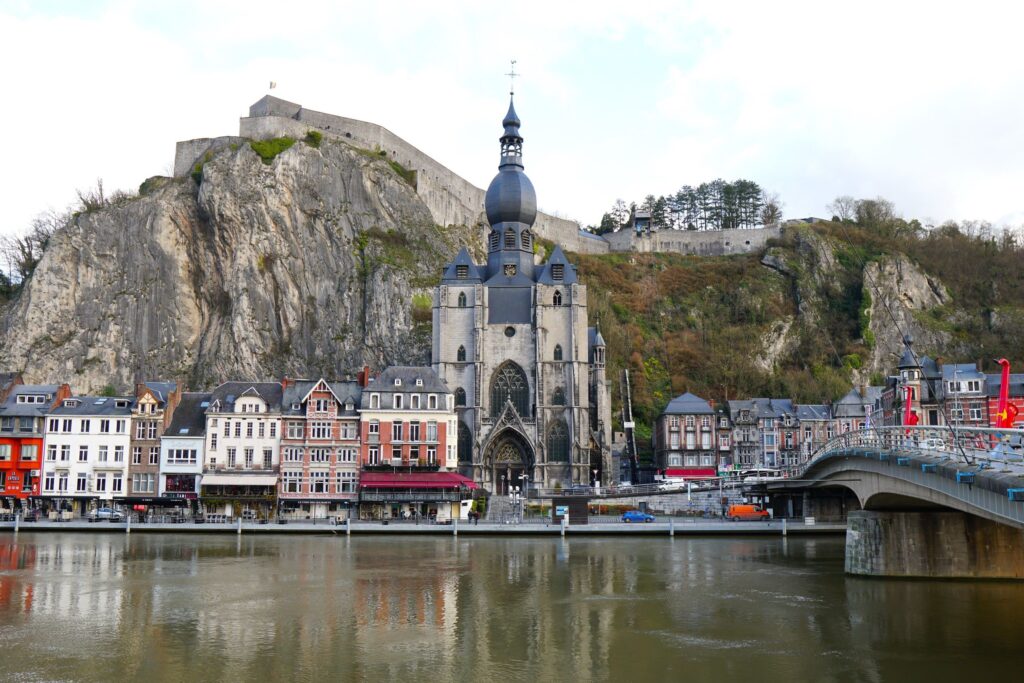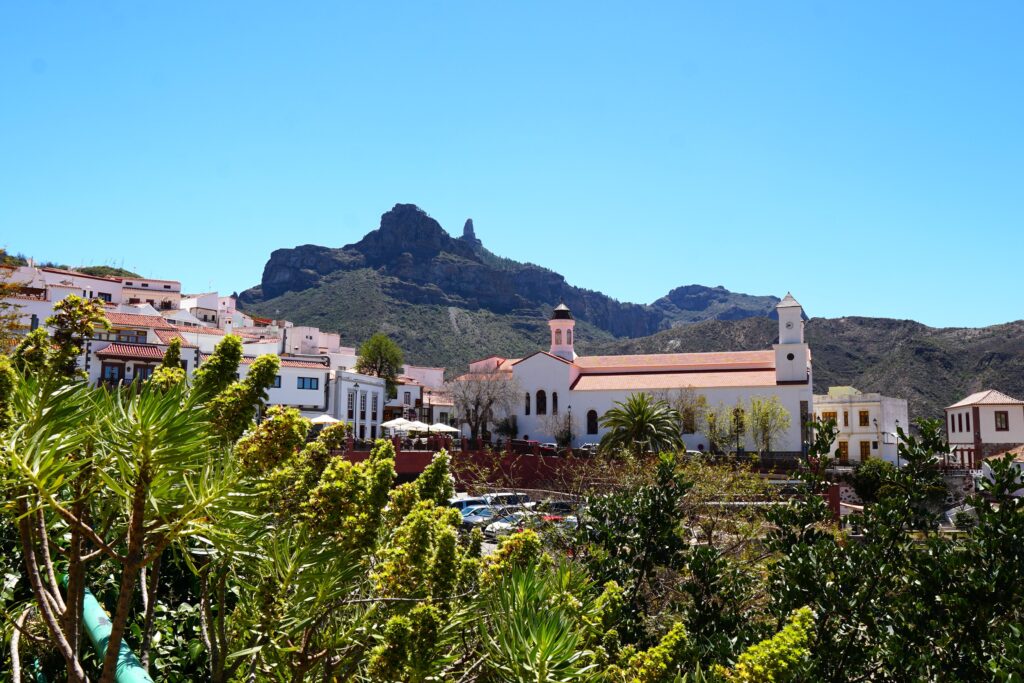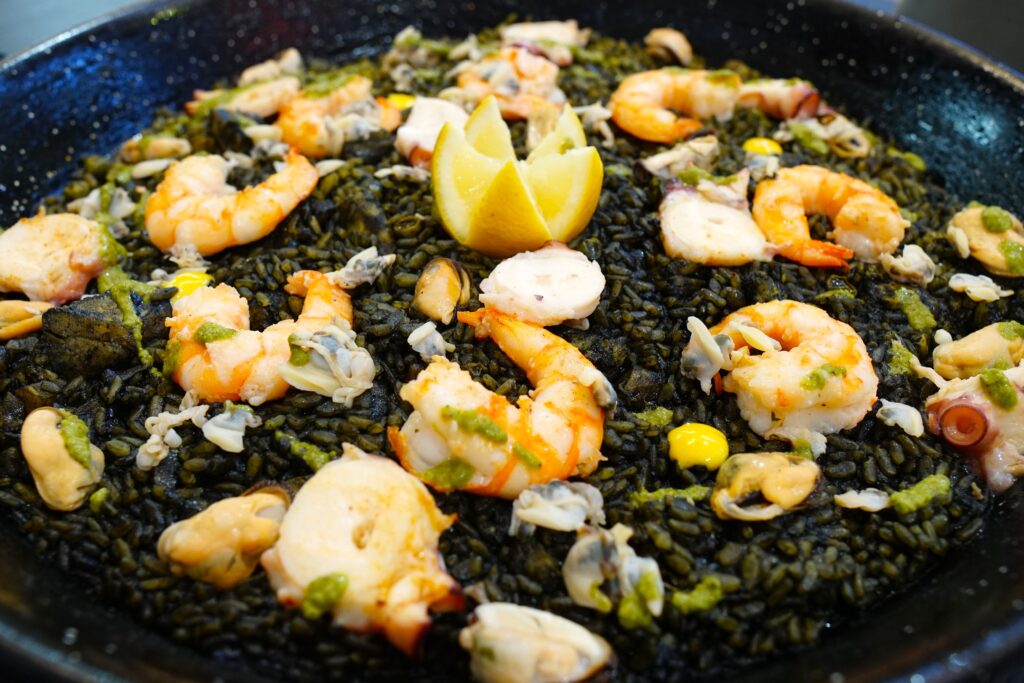As we arrive in Dinant, Belgium, the temperature hover near freezing, yet the sun’s gentle rays bathe the town in a golden warmth, making the chill almost unnoticeable. Our journey leads us past the impressive Rocher Bayard, a towering 40-meter limestone formation split dramatically in two. Folklore has it that the giant horse Bayard split the rock with a mighty kick, creating this striking passage.
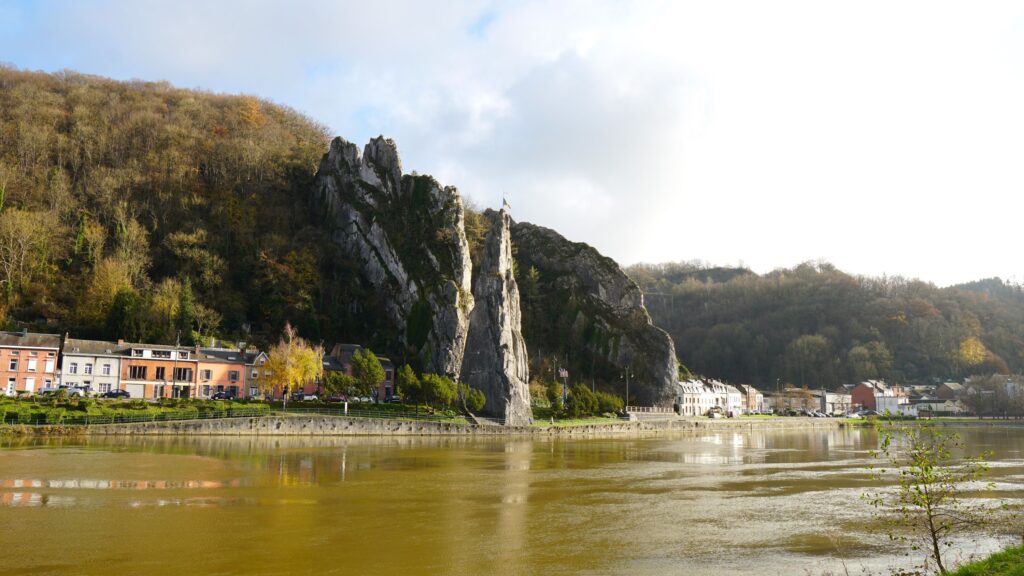
Situated along the Meuse River and surrounded by hills, Dinant is a very picturesque town. Our first destination is the Collegiate Church of Our Lady, known locally as Église Collégiale Notre-Dame. This Gothic structure, with its distinctive pear-shaped spire, stands gracefully against the backdrop of towering cliffs.
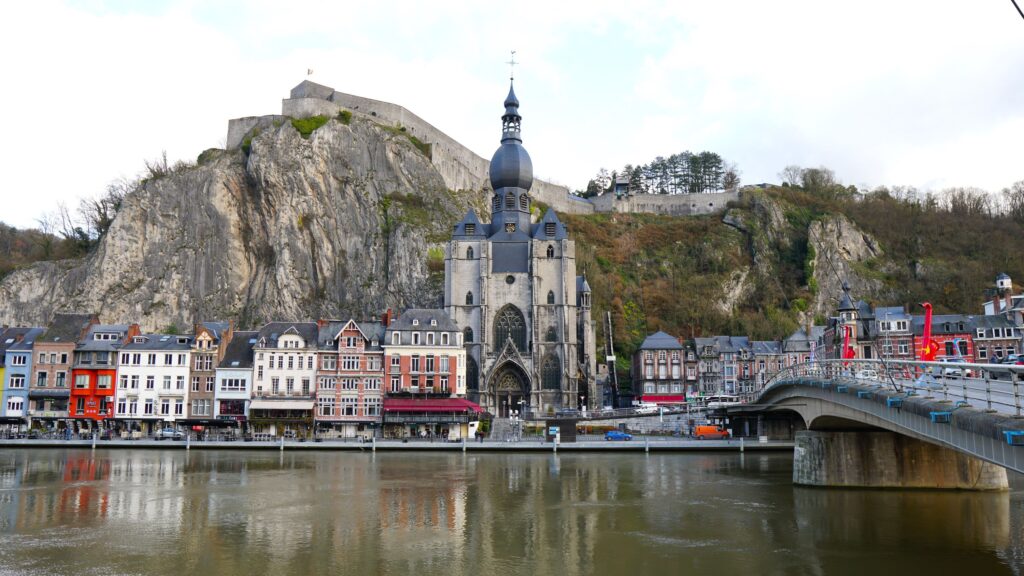
Constructed entirely from local grey limestone, the church’s dark façade has a solemn beauty.
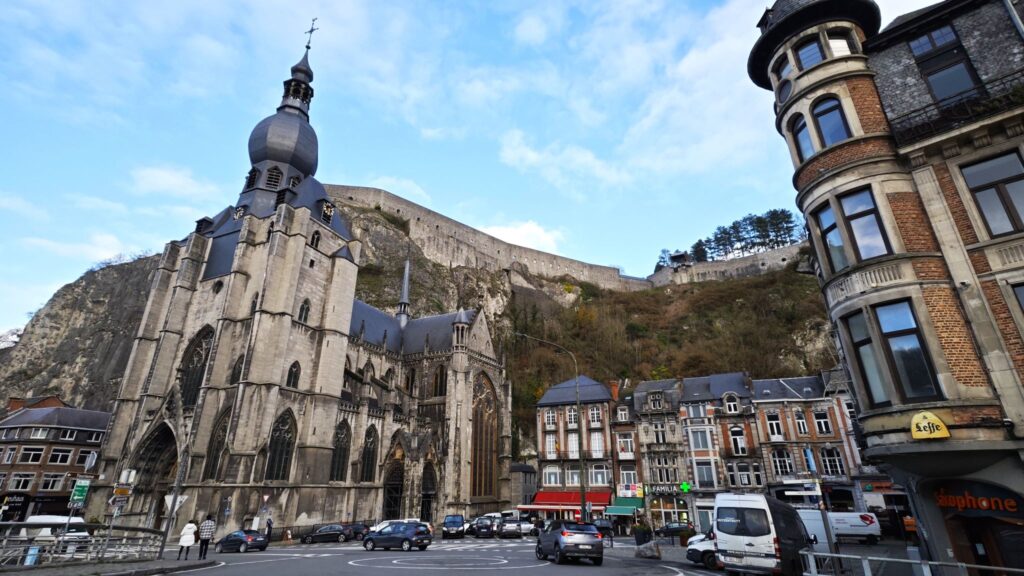
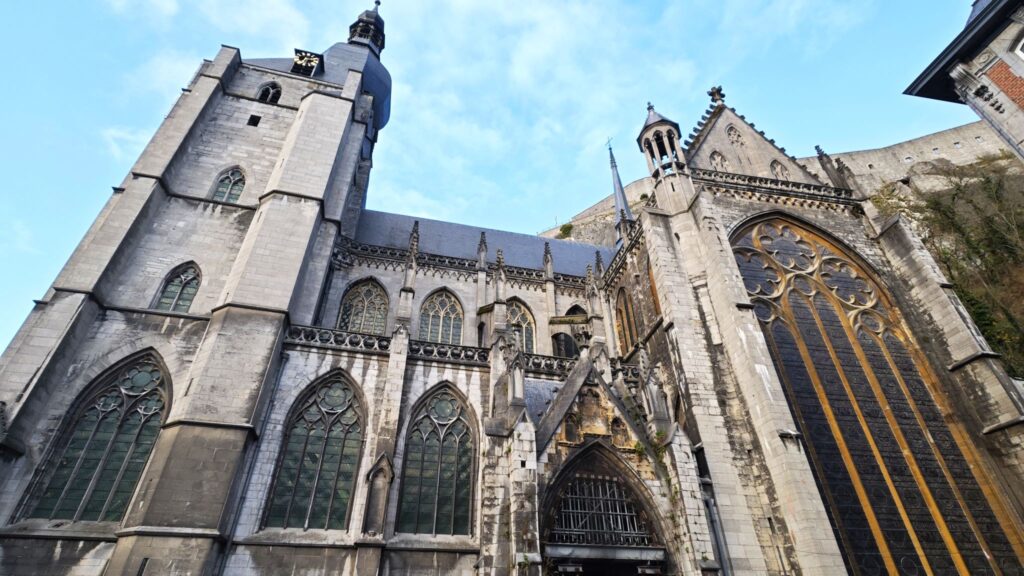
Inside, the dimly lit interior is adorned with dark stone walls and illuminated by a stunning stained glass window, casting a kaleidoscope of colors.
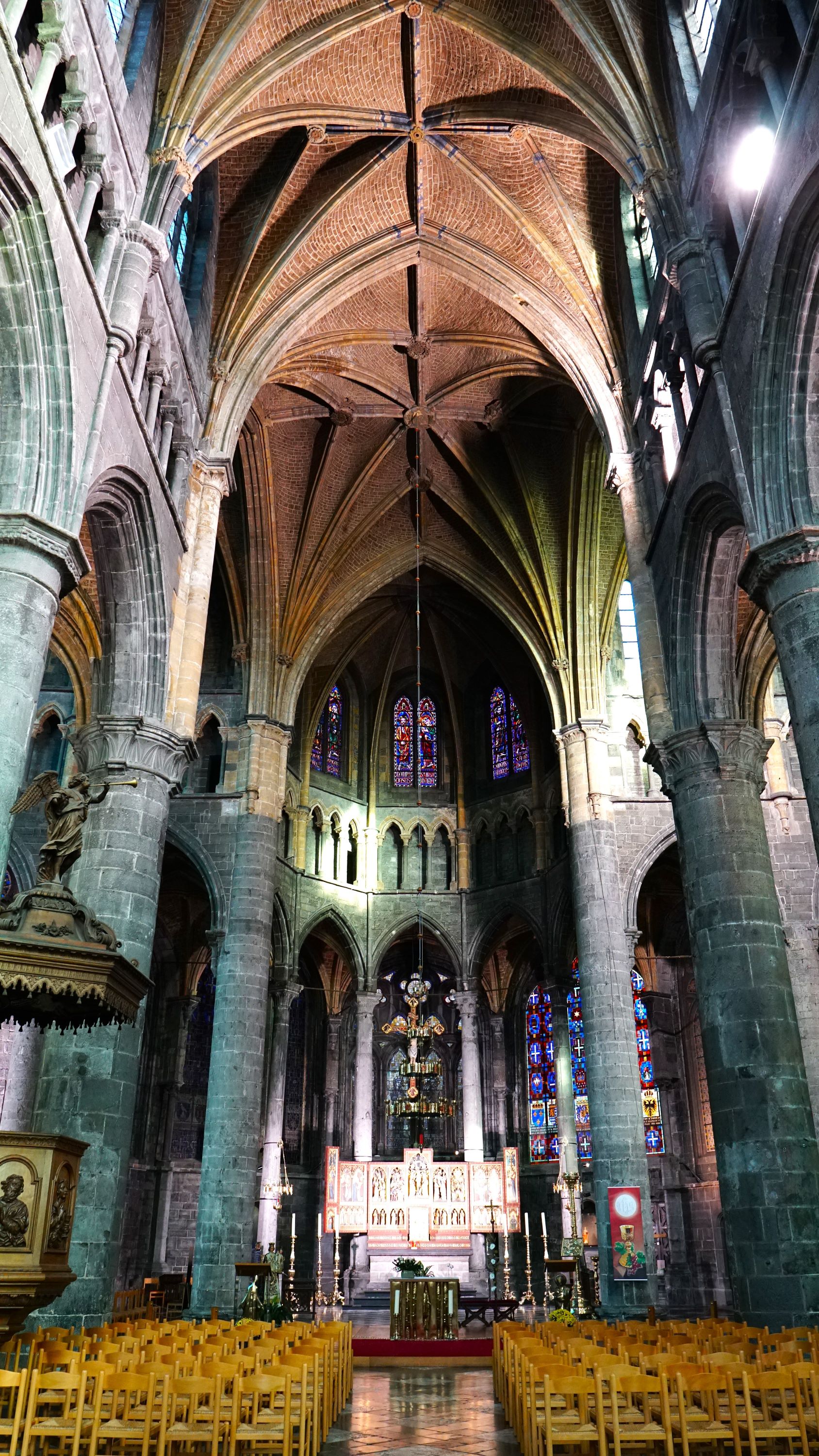
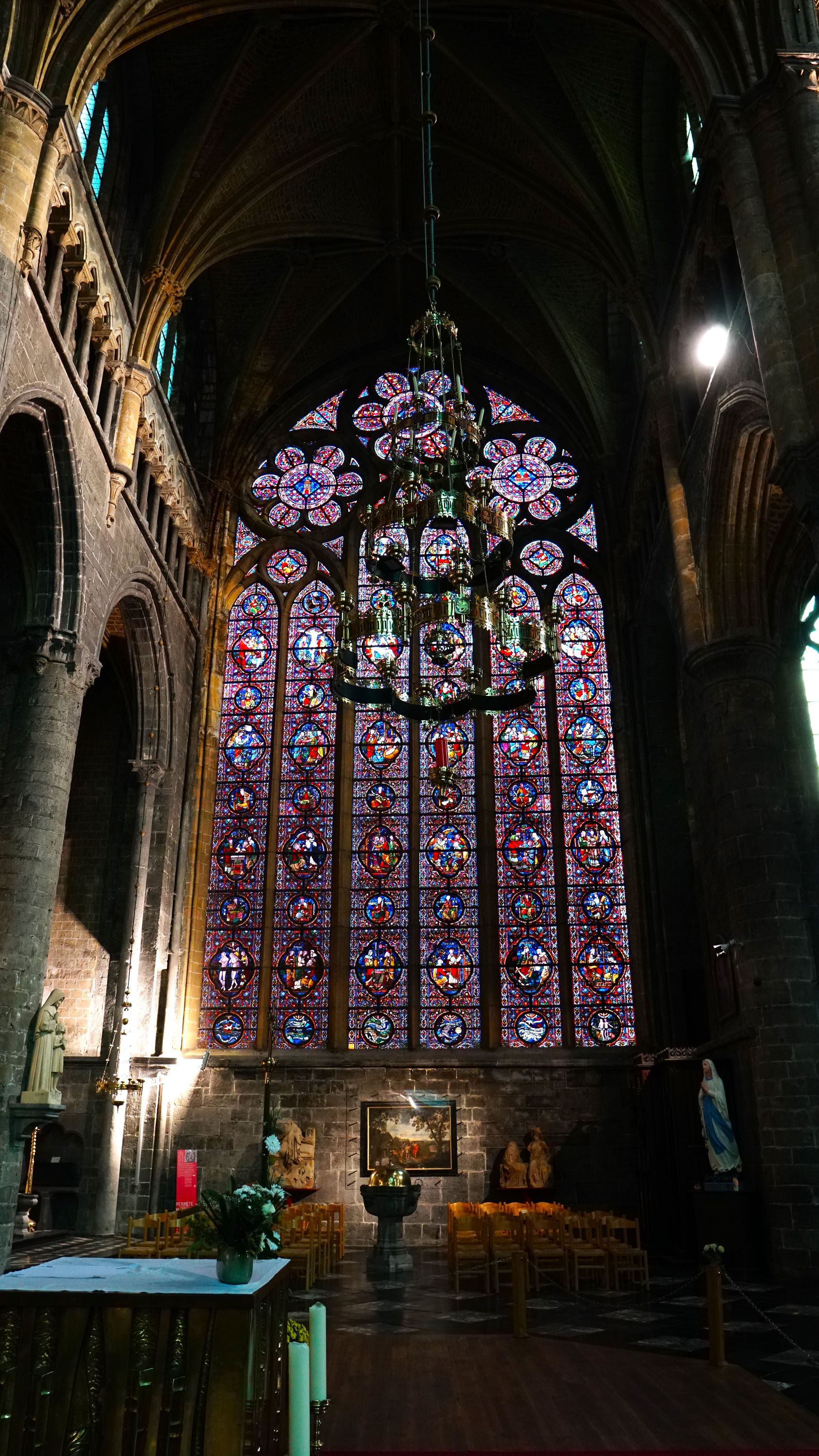
Perched high above the church is the Citadel of Dinant. Built in 1820, this fortress has witnessed significant historical events, including the Battle of Dinant during World War I. In August 1914, French and German forces clashed here, with the French aiding the Belgian defence. The battle resulted in substantial destruction and loss of life, leaving an indelible mark on the town’s history.
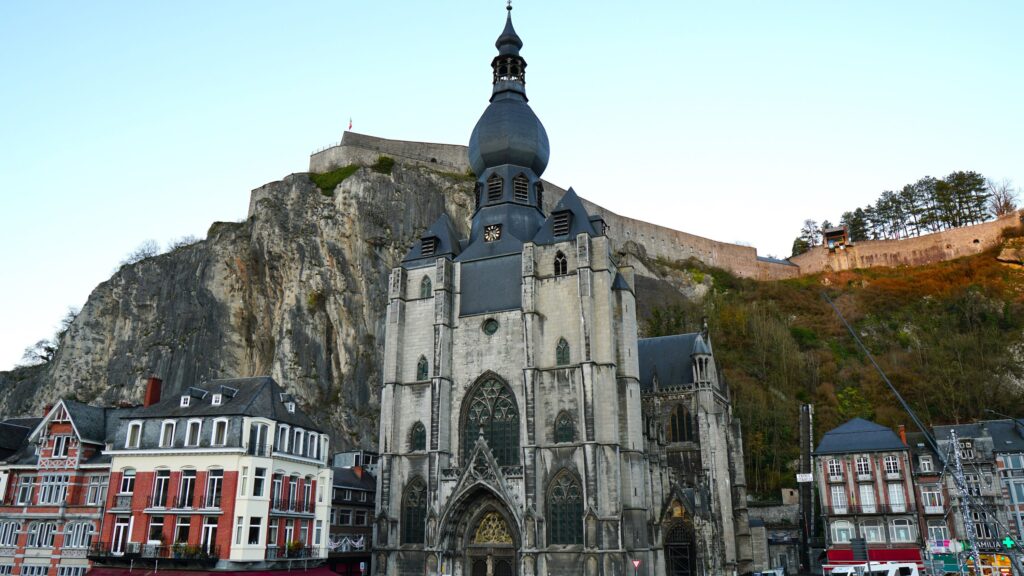
Inside, we see recreated scenes of wartime life: soldiers’ bedroom with a long rifle propped against the bed, a kitchen where meals were prepared under duress, and eerie sandbag fortifications. The dim lighting and lifelike mannequins—some crouching in fear, others lying motionless—brought the harrowing reality of war to life. It was a spine-chilling yet poignant.
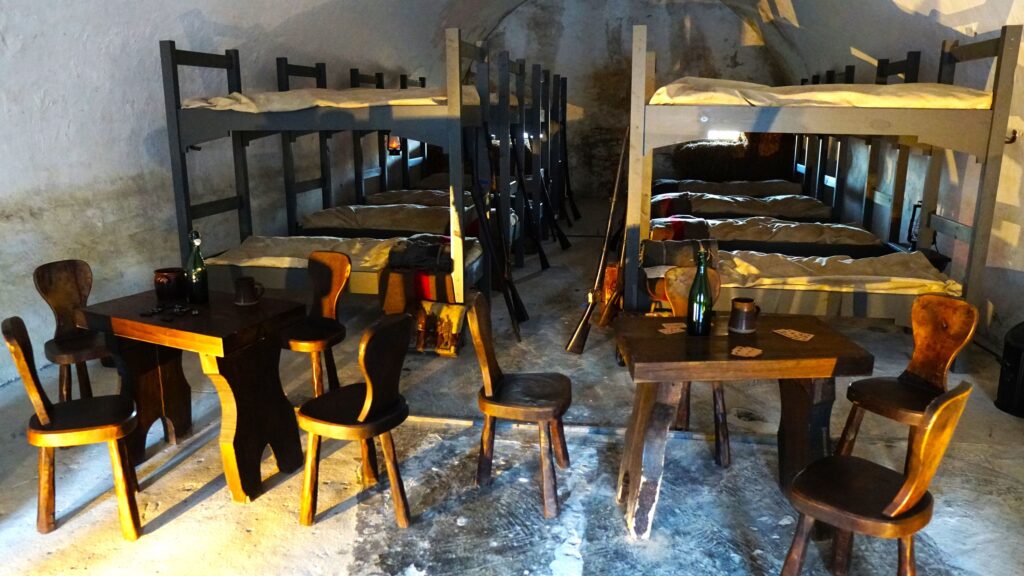
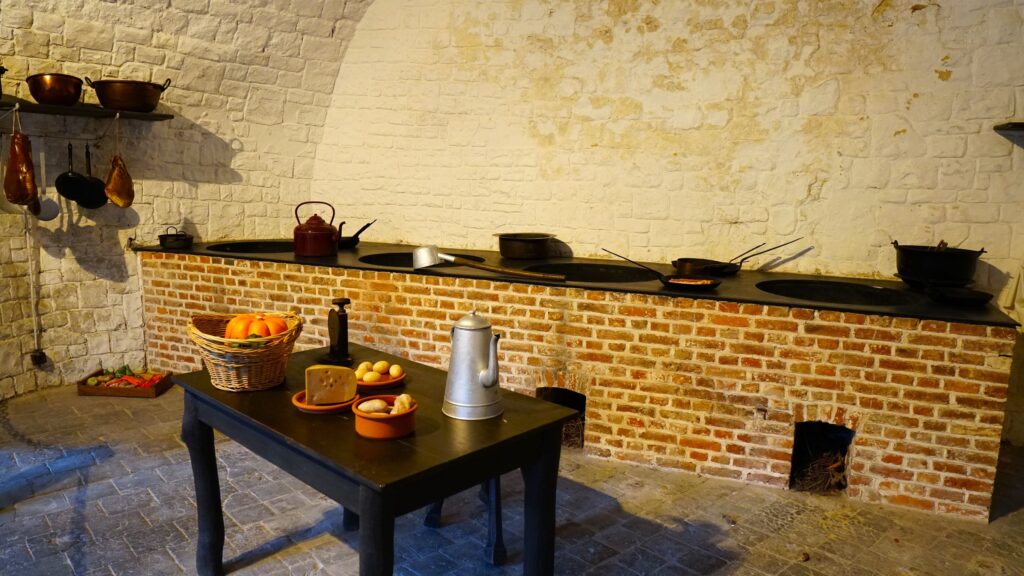
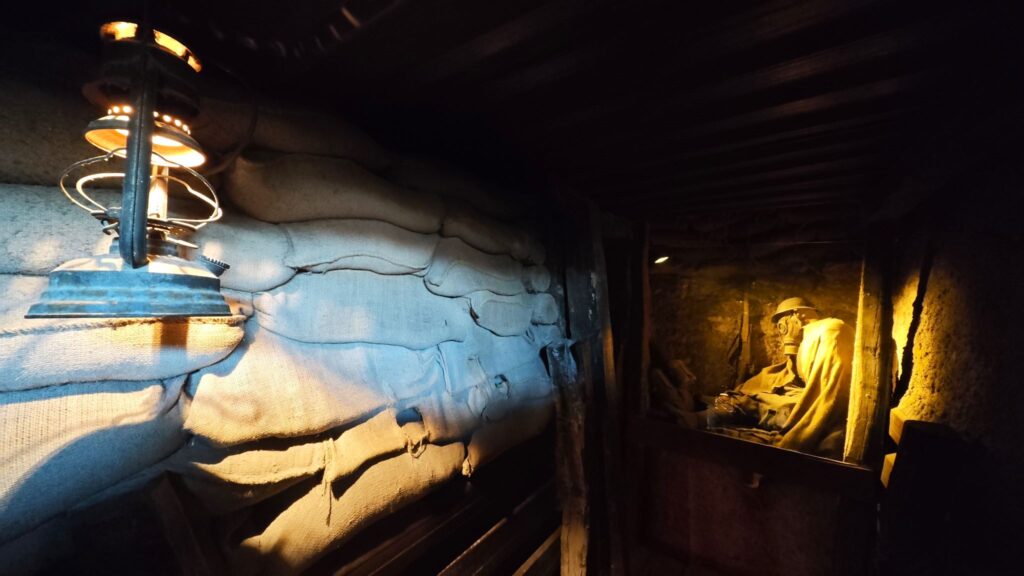
We struggle through the dimly lit tunnels, their skewed walls playing tricks on our senses. The Leaning Tunnel, as it’s called, is a disorienting experience—its slanted floor makes it almost impossible to walk straight, a clever design meant to confuse invaders.
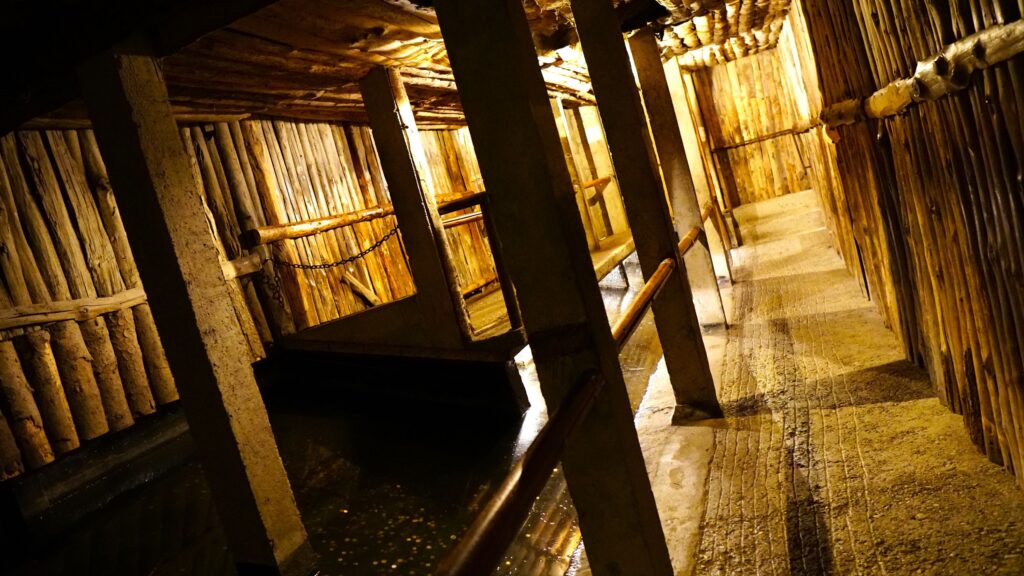
At the top of the Citadel, we emerge onto a vast, grassy plateau.
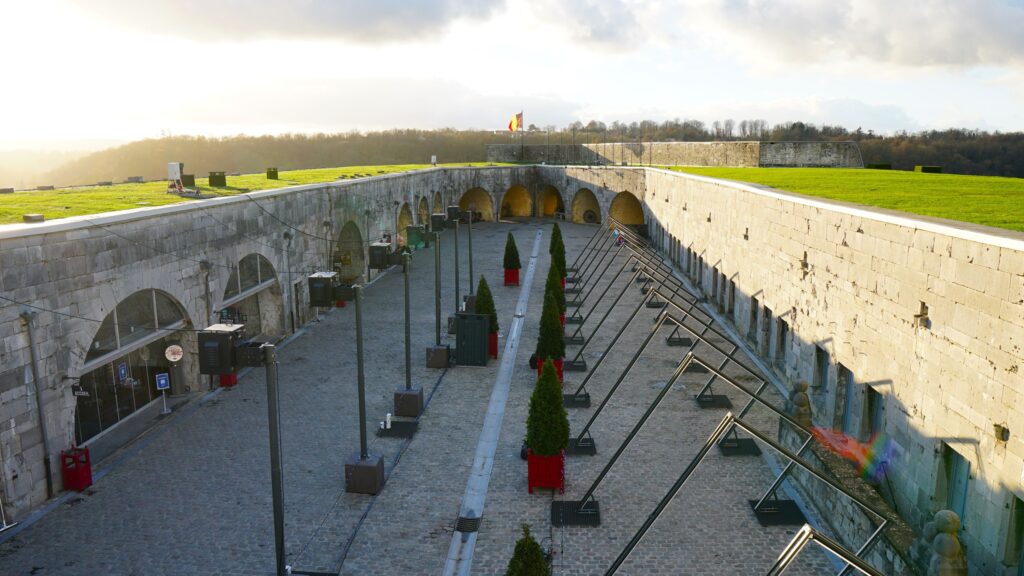
This area, part of the UNESCO-listed Meuse Valley, offers breathtaking views of Dinant below. The Meuse River, calm and reflective, divides the town like a silver ribbon.
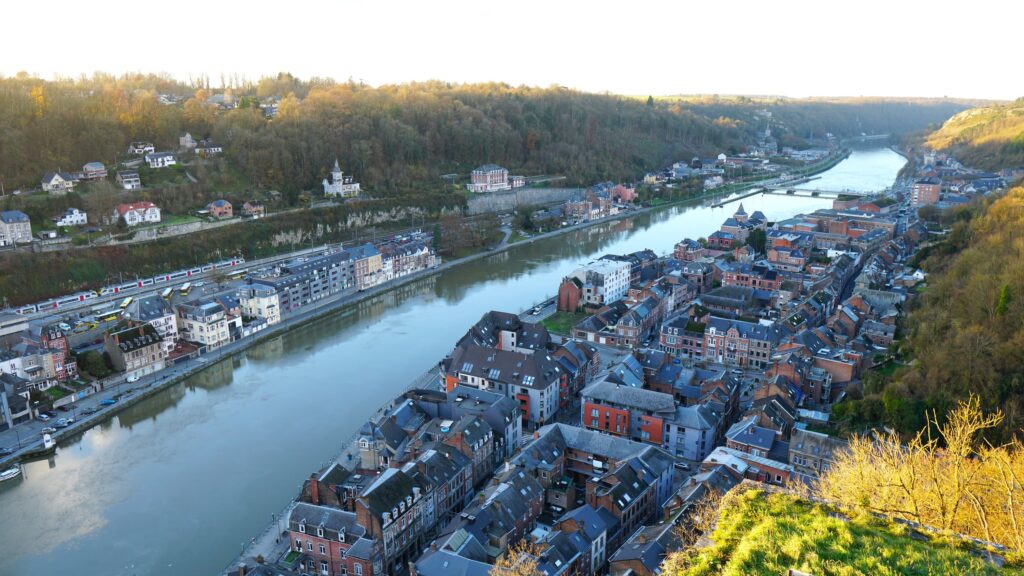
As the sun dips below the horizon, the sky and water meld seamlessly in the evening glow. This moment of tranquility forms a stark contrast to the fortress’s turbulent past.
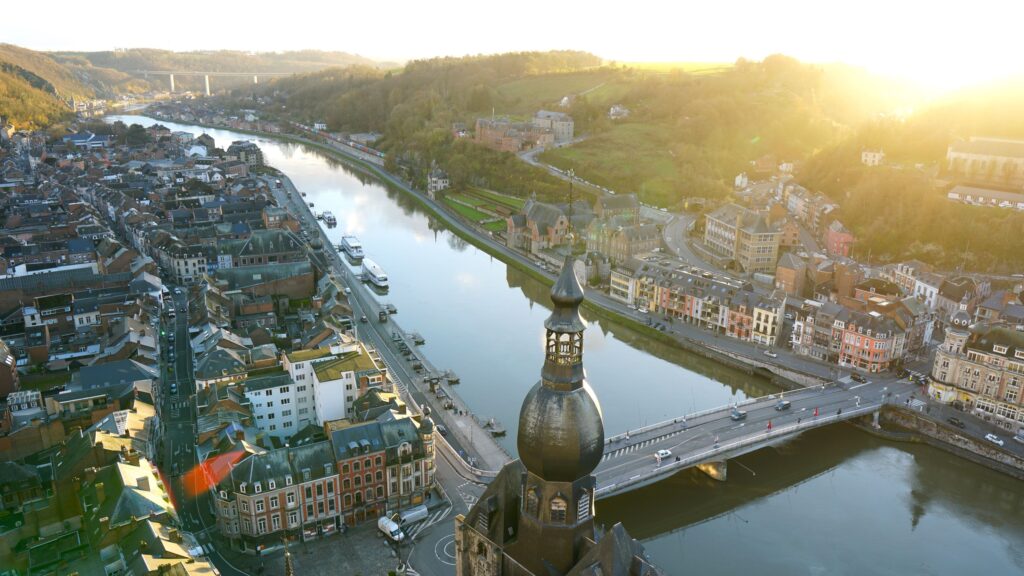
On our way back into town, we took a stroll along the riverbank. In the fading light and crisp air, the water lay still, mirroring the autumnal scene and the faint streetlights.
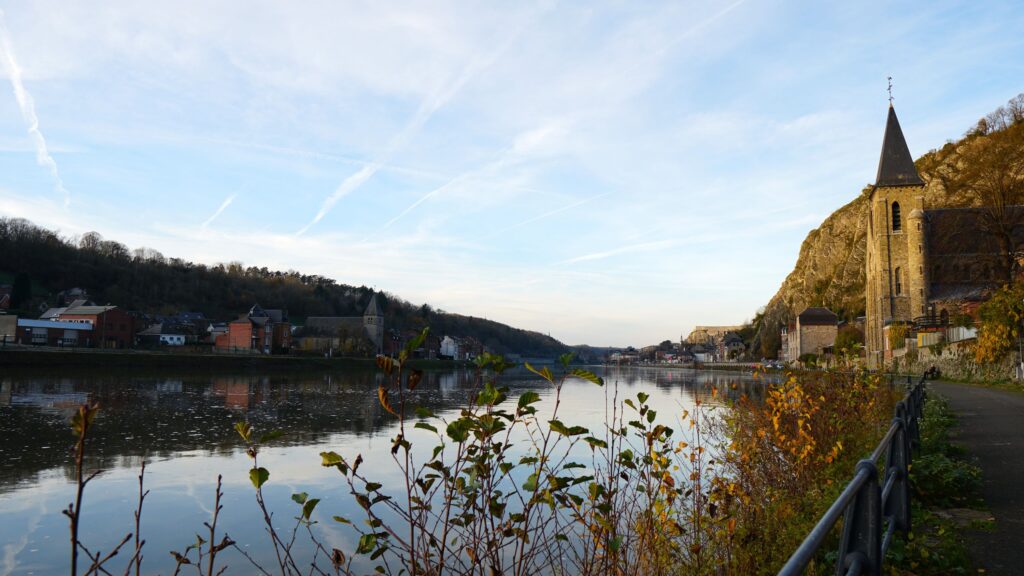
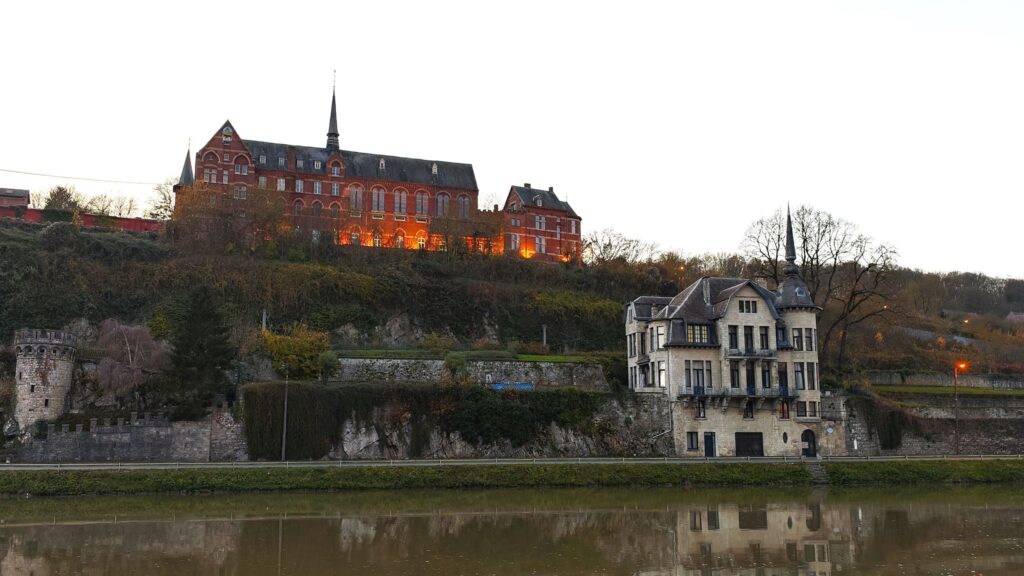
The subtle ripple of water barely disturbs its glass-like surface, reflecting the silhouettes of boats moored along the quay.
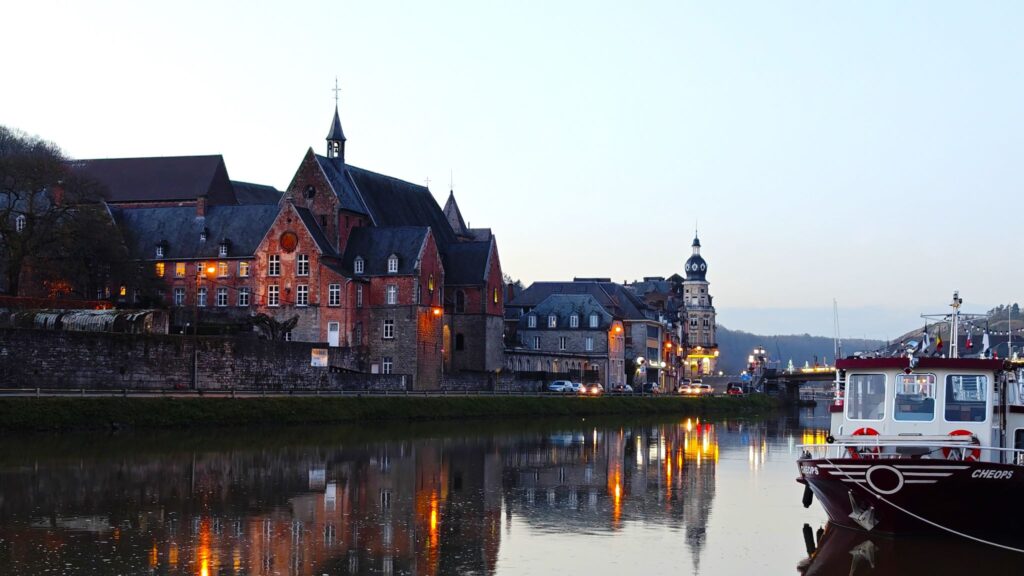
The houses of Dinant, many constructed from red brick, are of a distinctive Belgian style, with uniform facades and ornate gables.
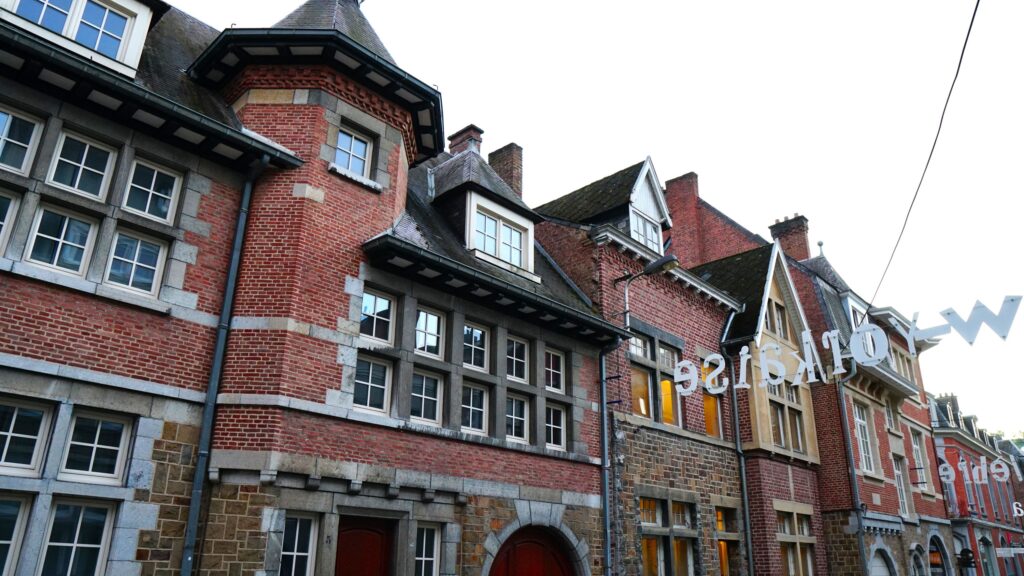
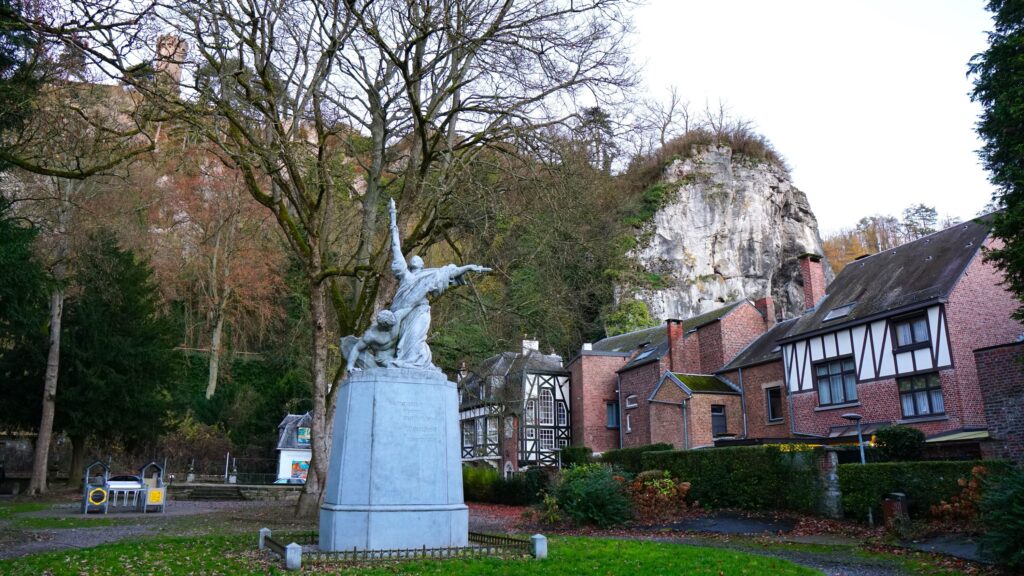
These structures, set against the imposing cliffs, create a very unique streetscape.
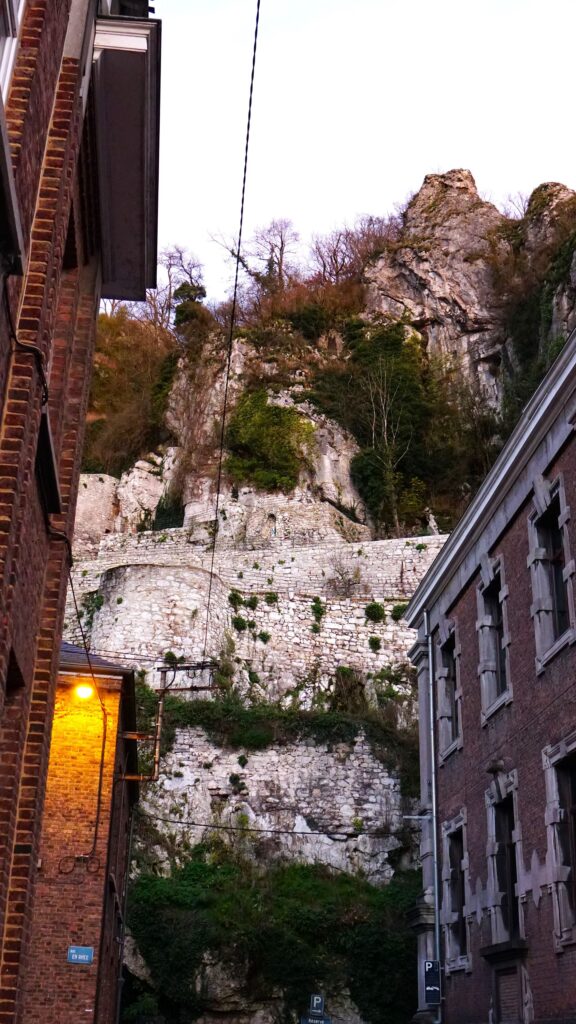
Twinkling Christmas decorations add a festive touch to the quiet evening.
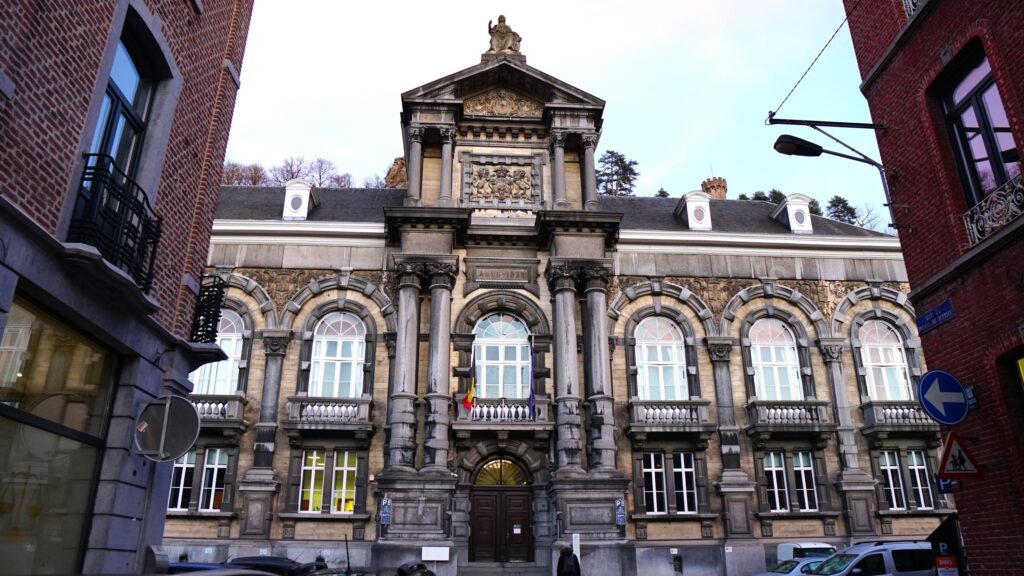
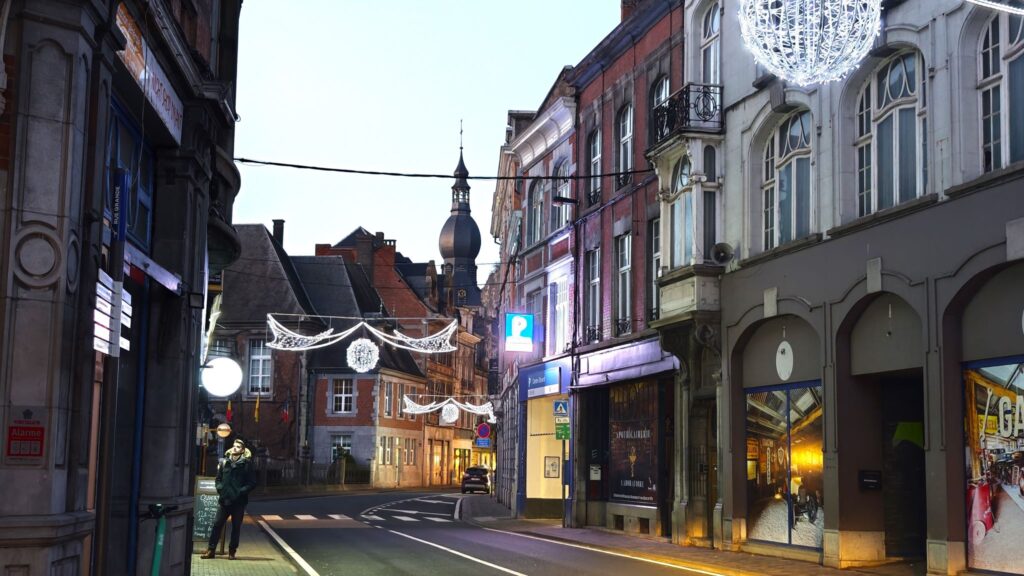
The sight of the Notre-Dame Church against the cliff is even more impressive from below.
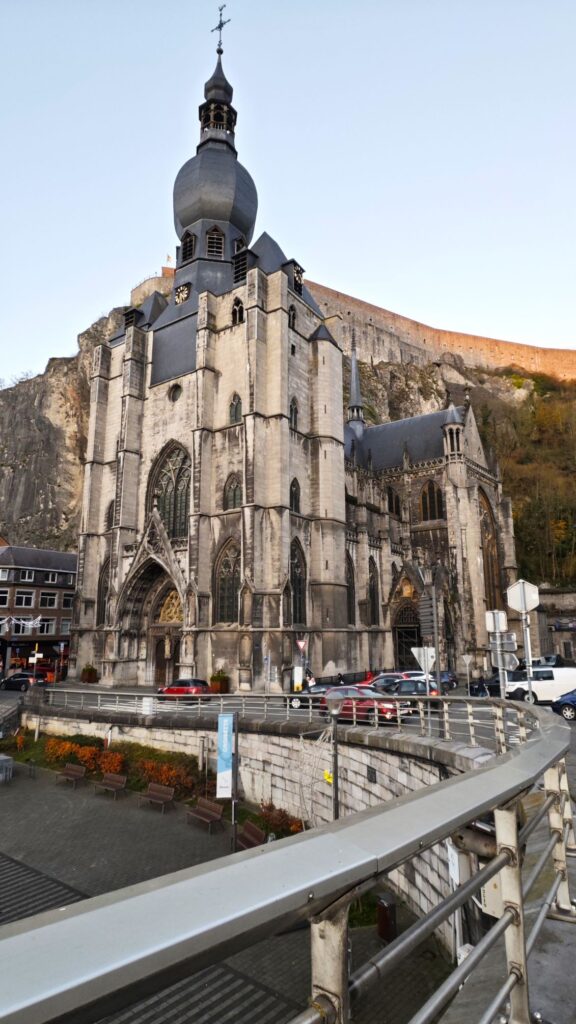
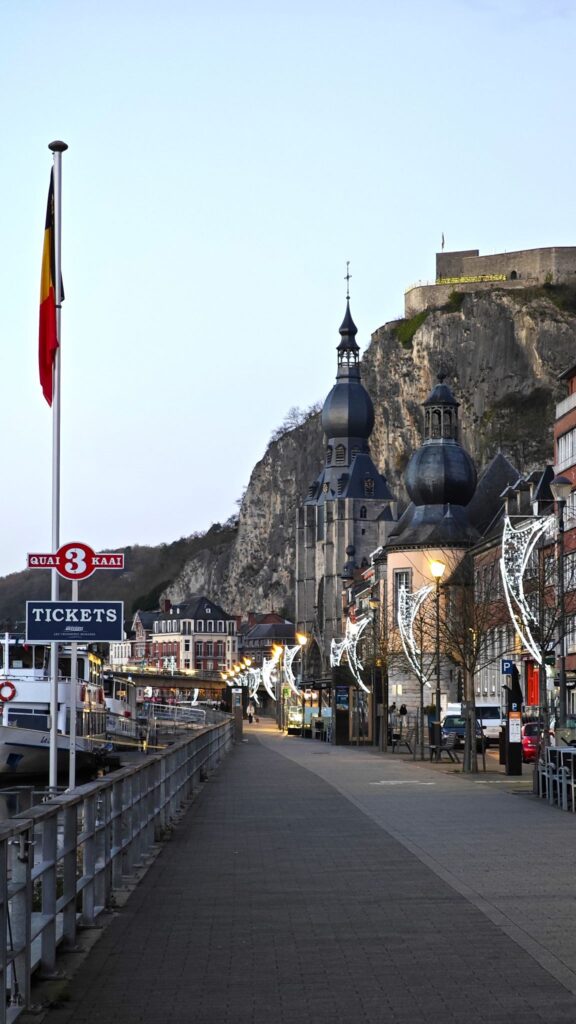
In the center of Dinant, we visit the Adolphe Sax Museum, dedicated to the town’s most famous son, the inventor of the saxophone.
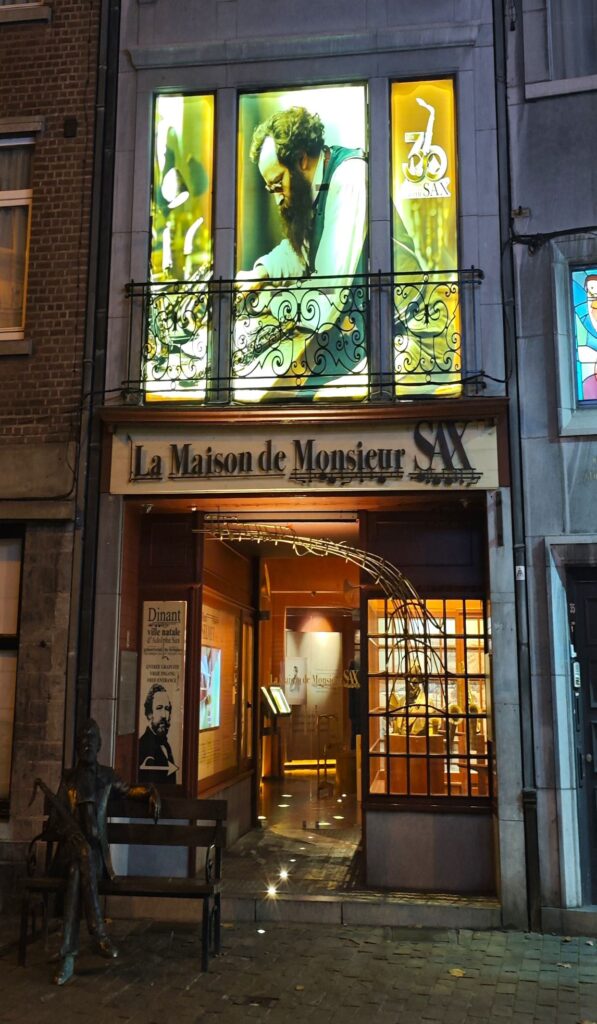
The museum offers insights into Sax’s life and his revolutionary creation.
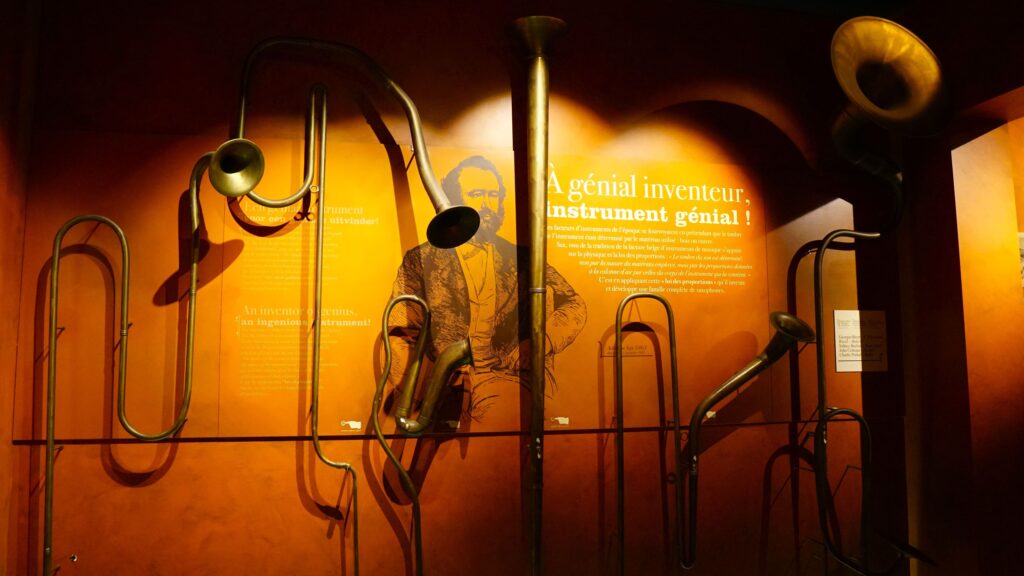

Throughout the town, his legacy is unmistakable. From the bronze statue of the instrument to Adolphe Sax himself, seated casually next to the museum, to the Saxophone Bridge (Pont Charles de Gaulle), lined with oversized, country-themed saxophones, Dinant proudly celebrate its musical heritage.
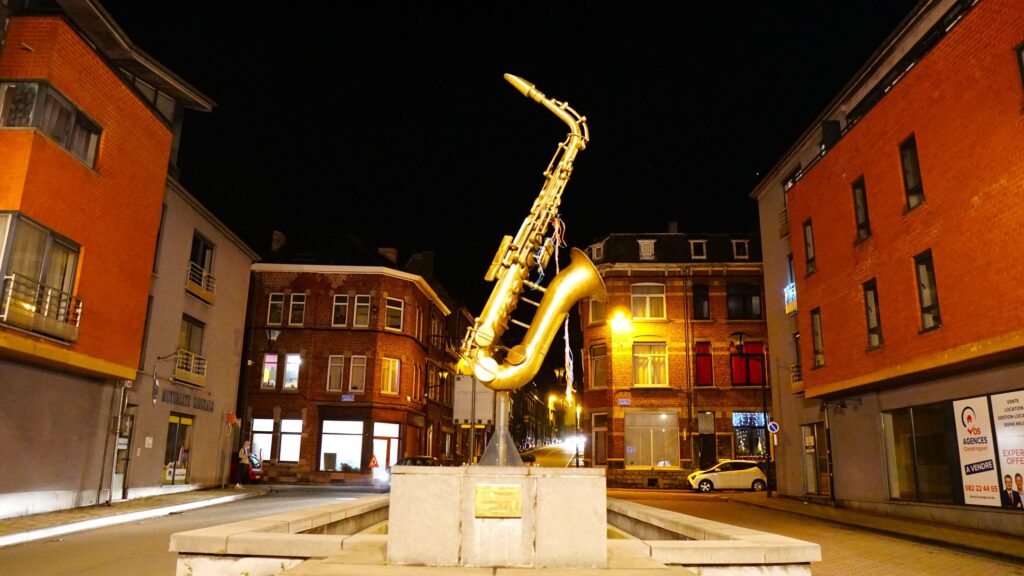
A striking glass saxophone sculpture graces the courtyard of the Dinant Town Hall. Created by Belgian artist Bernard Tirtiaux, it was installed in 2014 to commemorate the 200th birthday of Adolphe Sax.
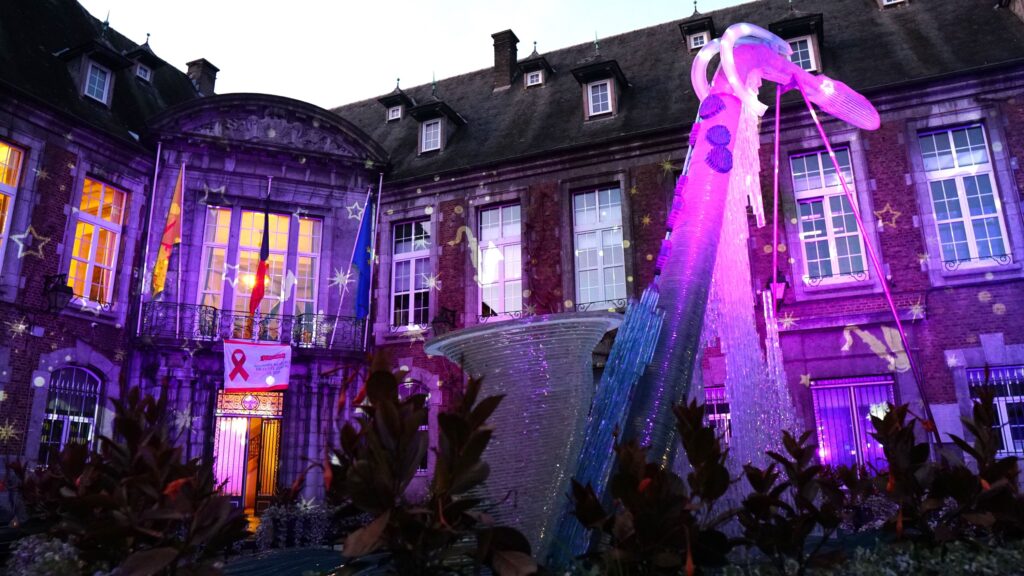
As the night deepens, Kaleidoscopic festive lights start swirling across the once stoic and still buildings, softening every edge and coaxing the night to sway with them, in a magical, joyous rhythm.
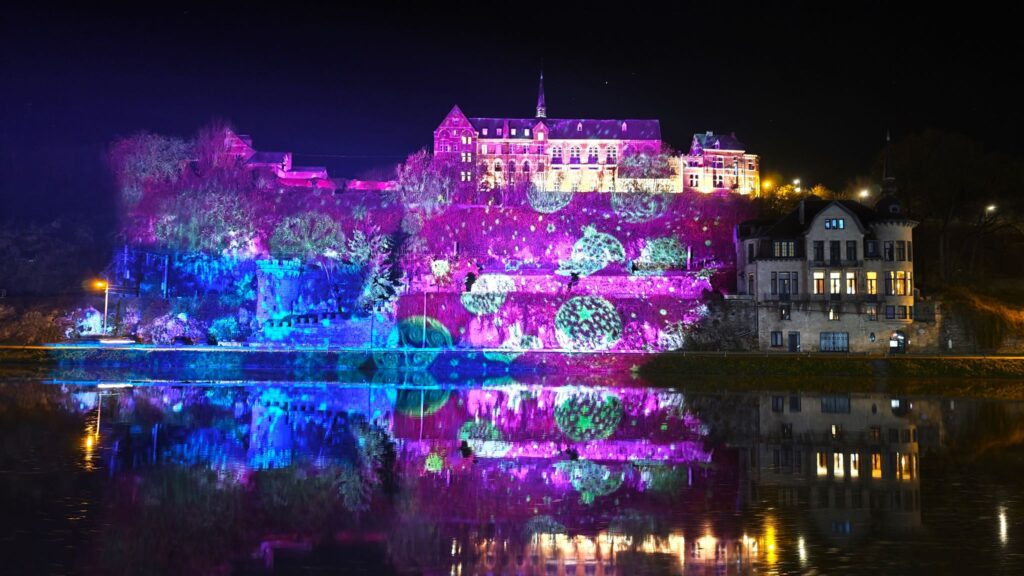
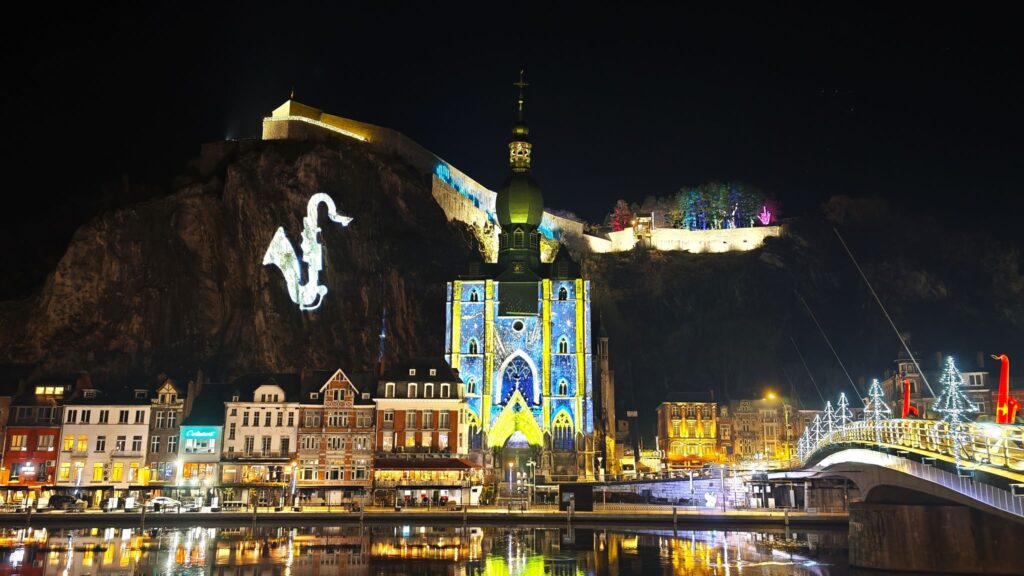
More tips for your visit:
Attractions & Tickets
- Citadel of Dinant: entry is €13 (adults), €11 (children). The 3-in-1 package (Citadel, cable car, boat trip) costs €22 (adults), €16 (children). More info.
- Collegiate Church of Notre Dame: free admission, open daily from 10:00 AM to 5:00 PM.
- Maison de Monsieur Sax (Adolphe Sax Museum): free entry, open 9:00 AM – 7:00 PM daily.
Getting There & Around
Nearest airport is Brussels (BRU). Direct trains connect Brussels and Namur to Dinant. The train station is within walking distance of major attractions. Parking is manageable but tight in peak seasons; payment is required until 5:00 PM—locals suggest it’s optional/free after.
Accommodation
Recommend to stay by the Meuse River for scenic views.
Price range:
💸 Budget: €60-€90/night
🏡 Mid-Range: €100-€150/night
✨ Luxury: €200+/night
During the off-season, some restaurants might be closed, but we lucked out and found Les Cinq Fontaines, a cozy Greek restaurant.
You really can’t go wrong with Greek food, and this place proves just that. Their menu includes classic Greek dishes—grilled meats, hearty stews, and generous seafood platters—all looking very tempting.
Our first dish is Scampi Diabolique Pikant. A fusion of Mediterranean seafood richness and a devilishly spicy kick, it lives up to its name—”Diabolique” hinting at its fiery heat.
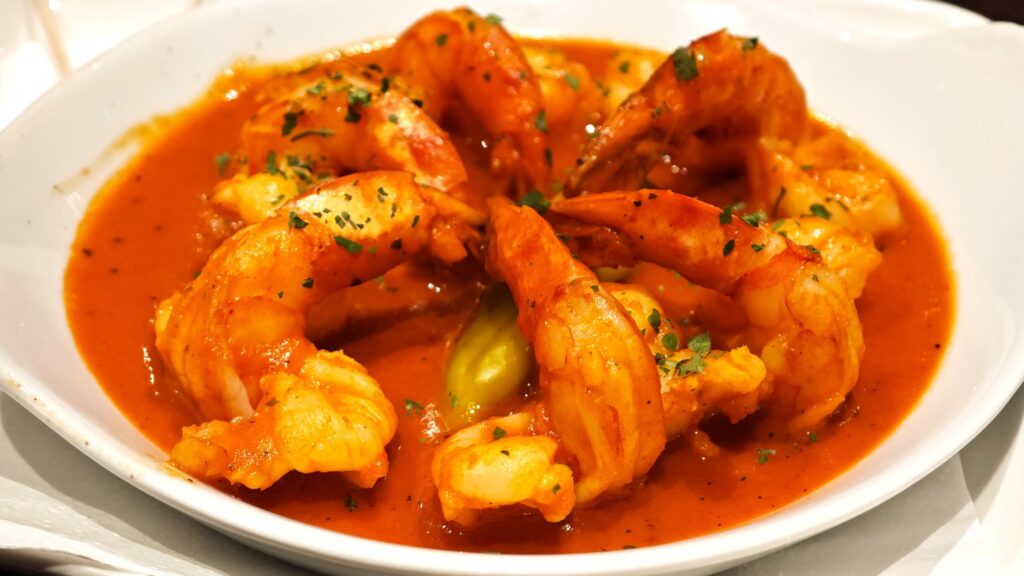
At the base are a few Pepperoncini (Greek green peppers), known for their tangy, sour heat, contrasting nicely with the rich, creamy sauce.
The sauce itself is a luscious blend—creamy yet spicy, with a hint of tanginess from tomatoes. The heat is well-balanced, giving each bite a warm, lingering kick without overpowering the scampi.
The scampi is juicy, plump, tender, and slightly sweet. They soaked up the fiery creaminess of the sauce, making every bite indulgent and thrilling.
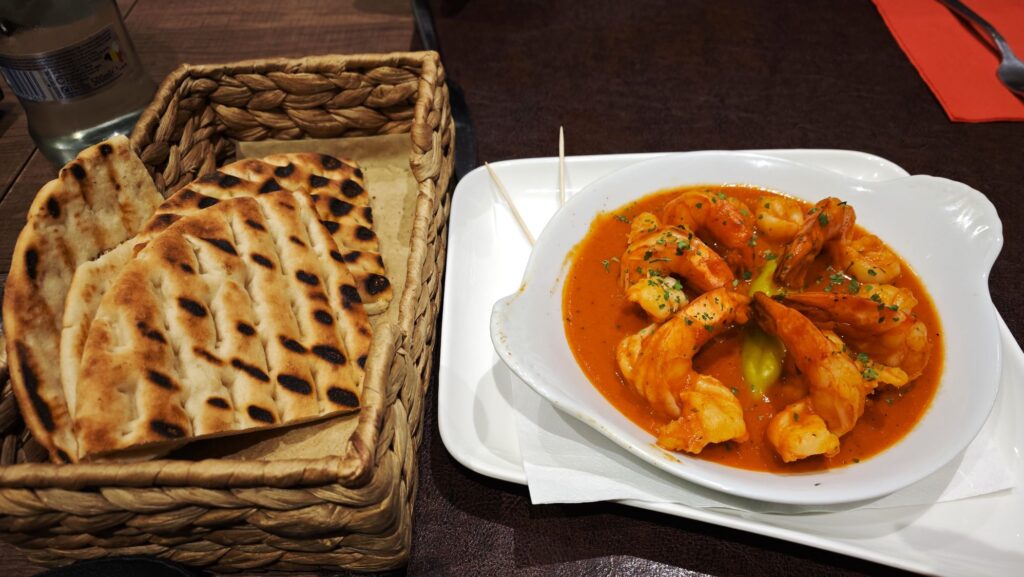
Served alongside is a portion of charred flatbread or Pita, with a lightly crisped surface and a hint of smokiness. They’re perfect for scooping up every last bit of that rich, flavorful sauce!
Kokinisto with Greek Pasta is a traditional Greek stew and a very hearty, flavorful dish. It features tender lamb cooked in a rich tomato-based sauce, often called kakavia.
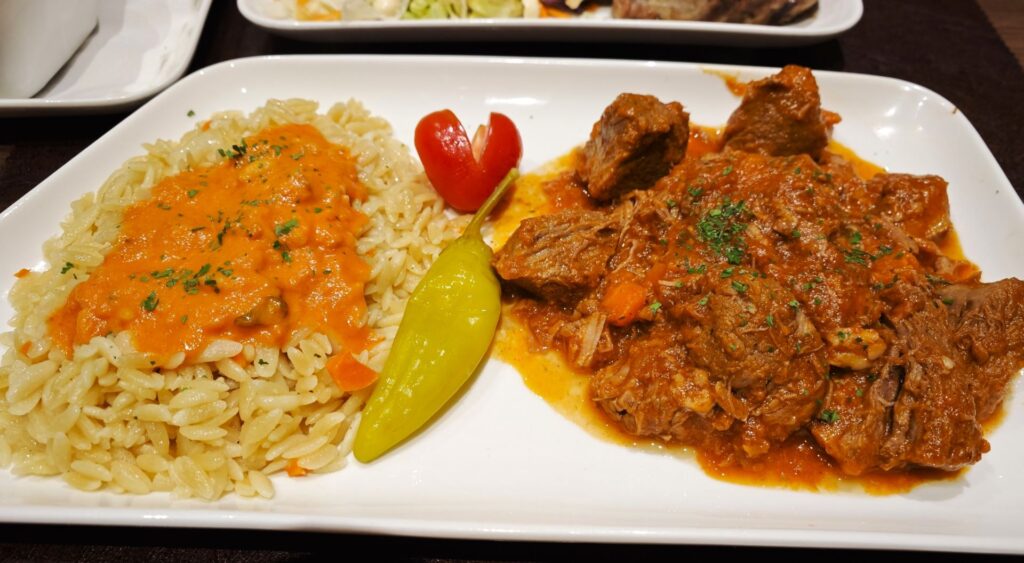
The sauce has a delicate balance between sweetness and a slight tanginess, enriched with aromatic garlic and onion. The lamb is slow-cooked in this sauce, achieving a flavorful depth and a satisfying, savory richness.
The dish comes with a type of Greek pasta, known as Orzo. These small pasta pieces are traditionally made from flour, water, and sometimes eggs. They have a unique shape—almost like large grains of rice—and a great ability to soak up the stew, making each mouthfeel cozy and fulfilling. Their soft, chewy texture complements succulent lamb wonderfully.
The lamb itself is exceptionally soft. The meat practically dissolves at the slightest chew, bringing a tender, meaty, juicy experience that blends beautifully with the tangy sauce. The carrots in the stew almost melt, adding a bright sweetness, while the oregano on top contribute a delightful herbal note.
The Mixed Grill is an absolute highlight, bringing together a selection of chicken, beef, lamb, pork, sausage, and ribs.

The beef is a bit charred on the outside with a hint of pink in the center. It’s tender, juicy, and packed with a deep, smoky aroma. The sausage is incredibly soft and mushy on the inside, with a slightly tangy, almost sour note and a burst of bold, seasoned flavor.
The pork is juicy, smoky, and flavorful, while the lamb carries the strongest, most distinct flavor on the plate—a deep, rich taste that lamb lovers will love. The smokiness from the grill nicely enhances its natural gaminess. The lean chicken meat is surprisingly moist and tender, with a delicious smokiness typical of traditional Greek charcoal grilling.
This dish is paired with French fries and a fresh side salad of crisp lettuce, juicy tomatoes, crunchy carrots, cooling cucumber slices, and red cabbage. Fresh onions add a mild sharpness, while a dollop of creamy, garlicky Greek yogurt tzatziki soothes the palate with its refreshing tang.
Dinant is small but charming, with most of the sights within walking distance, making it very comfortable to explore. A little further out there are also many other places worth visiting. Next time, we’ll set out to discover the Château de Walzin, a fairytale fortress gleaming white against the cliffs above the Lesse River. We’ll also delve into the depths of Grotte La Merveilleuse, a cave unearthed in 1904 and considered one of the most beautiful caves in Belgium. Until then, we bid Dinant a fond farewell, with new landscapes waiting just beyond the horizon.

